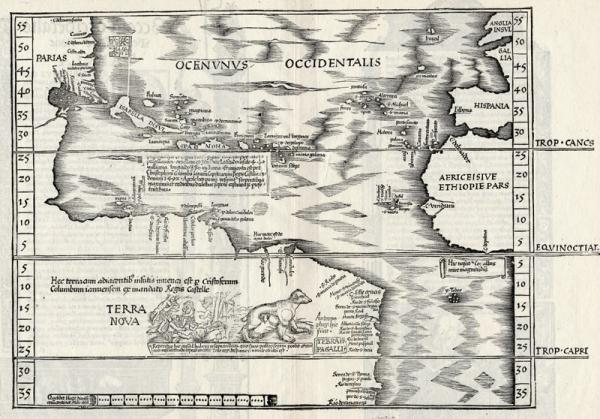Terra Nova [Map of New World]

New World; Admiral's map, opposum, depiction of cannibalism in South America
[Fries, Laurent]
[Strassburg]
Map is based closely on cartography of Martin Waldseemuller. Later realization that credit for the New World should be given to Columbus is reflected in this version by Laurent Fries, who added a Latin description below the Hispaniola explaining its discovery by Clumbus. Acknowledgemnt of Columbus' discovery is printed across the interior of the new land. Servetus was later burned at the stake for an heretical comment printed on his map of the Holy Land., and copies of his maps were ordered destroyed on orders of John Calvin. A peninsula to the northeast of Cuba is from an unknown source. Some suggest it is an early depiction of Florida, giving rise to speculation that there was an unrecorded voyage to Florida prior to its official discovery.
From Fries' 1525 edition of Claudius Ptolemy's "Geographica." This map, closely based on Waldseemüller's 1507 map of the New World, is one of the most influential early printed European maps of the New World. This work is often called "The Admiral's Map," because of the notation (written on South America) that the geographic information was obtained directly from charts drawn by Christopher Columbus, admiral of the Ocean Sea. Cuba ("Isabel"), Haiti ("Spangnolla,") Jamaica ("Iamaiqua,") and theAtlantic Coast from Florida northward are shown here. One of the map's distinguishing features is the cartouche depicting an opossum. The first marsupial creature ever seen by Europeans, the opossum engendered much curiosity. A 1499 description of the animal noted that it was a strange monster that carried its young in a great bag hanging from its belly. This unusual animal was said to have the head of a fox, the hindquarters of a monkey, the feet of a man, and the ears of an owl.